
This is dedicated to all the people who helped form this unbelievable summer. Thank-you for sharing this small/enormous part of Iceland with me; I couldn't have imagined it would be this magical.

Finding the time alone and energy to write anything has been nearly impossible. Metaphors waft through my mind like a fleeting mist, rarely leaving any residue and almost never making it onto paper. We live in the mountains and have done since the beginning of May; they are too unpredictable and treacherous to tame into a "home", but I don't want to be anywhere else.
After nine weeks of camping and volunteer trail work down in Þórsmörk and Goðaland, we found ourselves in proper jobs as hut and campsite "wardens" along the Laugavegur hiking trail. For now we have fallen on our feet and (apart from when I occasionally forget to remember) I feel unimaginable lucky to be here.

I spent the first week in Langidalur (þórsmörk) drunk on excitement. May alternated between air thick with snow and full rubber waterproofs to brilliant sunshine. It was three days before we saw the third layer of elevation to the south, a snow covered swath of Eyjafjallajökull; the invading tongues of Mýrdalsjökull fought the mist to the east. On a clear morning I could drink coffee with a view of these two glaciers at once. We worked hard, with the seemingly unique drive of like-minded volunteers, and hiked as much as possible.
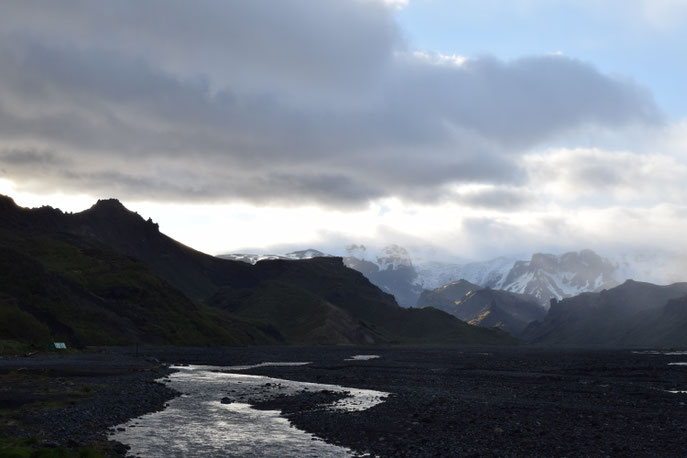

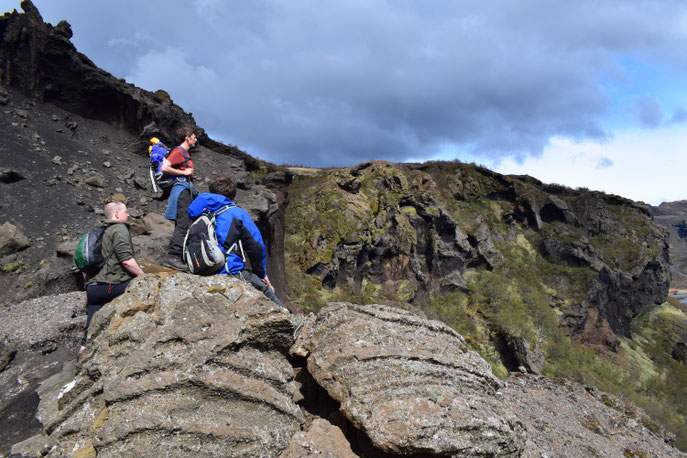


The best of the work was the toughest. At the beginning of May, with snow on the ground, I couldn't understand the enthusiasm of one returning volunteer to carry logs. We assumed he was either sarcastic or mad, but a few weeks later, as the task became just a little easier every time, I seconded him. Some evenings we toasted marshmallows on the bonfire and gradually watched the hours of twilight dwindle to none.
There were more song birds than I had imagined and everything was fearless. The warbling snipe, brown thrushes and the startlingly white male ptarmigan - once camouflaged in snow, now remaining bright as a distraction from his mate and their chicks. The prevalent mice and arctic foxes (tamed and bold from human feeding) were the only mammals I saw. Smaller than ours and more fluffy, I could hardly think of either of them as a pest.

As the summer developed, we lost the chill. Once a sad collection of upright twigs, the birch trees began to sprout leaves and the valley slowly turned green. Across the river in Básar, we lived in the forest and watched as our grassy carpet became sprinkled with flowers. When it rained, we were wet for the duration; the leaves, the grass and everything unprotected by layers of plastic was dripping.

We shared our woodland home with the nesting redwings, under the base of Réttafell (a daily battle ground) and Útigönguhöfði, a conical shaped mountain - a crown of thorns starfish with its arms severed. On a good day I felt like an elf.


We hiked and camped and fought erosion on the trails around Goðaland and Þórsmörk, getting to know the area with a fine-toothed comb and steadily spreading the perimeter of my spider-web mind map.
Camping close to Rjúpnafell (ptarmigan mountain) one week, for ease of access to the work site, we spent the evenings exploring the lesser seen valleys and ridges at the mountain's base. Sometimes I clamoured over the river boulders in bare feet, like Gollum, mostly on all fours for stealth and silence and to feel the rock under my toes. Treating it like lava or piranha-infested water, I avoided the moss; thick as a duvet in places.




We came out into a trolls' cathedral, where the river disappeared under rock; in a huge cave with a round sky-light. The walls were scooped inwards, overhanging and precarious. Tiny cities had formed from the drops.

It was around the middle of June when I first noticed lidarskart, though I didn't know its name. I thought somebody had spilt a trail of fertiliser, it was so unnaturally fluorescent green. "Spring jewellery" a warden friend told me later; it always appears around trickles of water. On our longest hike, from Landmannalaugar, through eight kilometres of snow, tent destroying wind and the most heart-warming team work I've experienced in a long time, the reemergence of chlorophyll fuelled life forms was reassuring.

When hikers complain of the conditions now in August, when Hrafntinnusker is almost totally clear of snow, I have to stop myself from scoffing; the hut was two meters deep when we arrived, nearly covering the windows.

I had seen geothermal activity before, in New Zealand and hot springs in Europe, but the area around Landmannalaugar was an entirely different thing. The colourfully stained rocks, tiny bubbling holes and rumbling ground were a little disconcerting and it felt wrong to inhale so much egg.

Our first length of the Laugavegur, 55km, took us through a whole range of new landscapes - snow bridges over steaming water, endless black lava fields and tiger-striped mountains; dense channels of moss. After six weeks in Þórsmörk and Goðaland, I was both excited and disconcerted to be in a different setting, slightly resenting the lack of green.
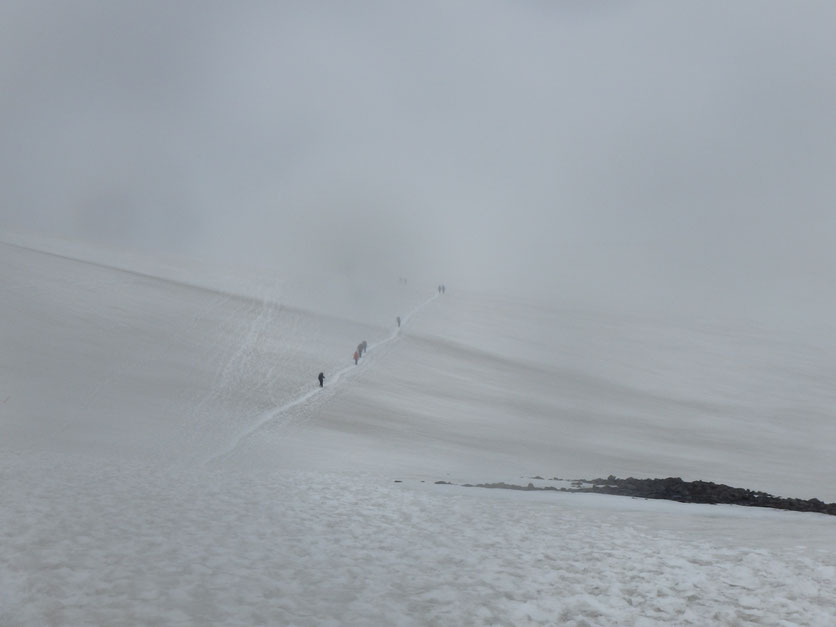
The wardens of each hut helped us along our way and I take inspiration from their un-flustered demeanour as I try to encourage miserable hikers along the trail in wet weather. It doesn't help to stop for too long in the cold.


By July our time was nearly over, but it didn't sink in that these people would soon be absent from my life. The weeks were so intense that I'd begun to treat them as an unruly family, bossing them about as I once did my own sister (sorry Jenny!) and forgetting that it wouldn't last forever.
I don't want to mention any names here, but I hope you realise how proud I was to be a part of your team, how much your kindness meant to me and how thankful I am for all your effort. I won't forget it.
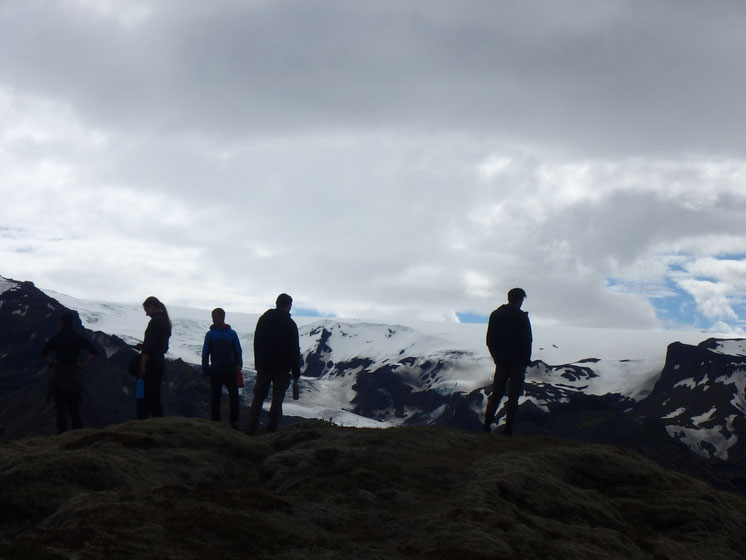
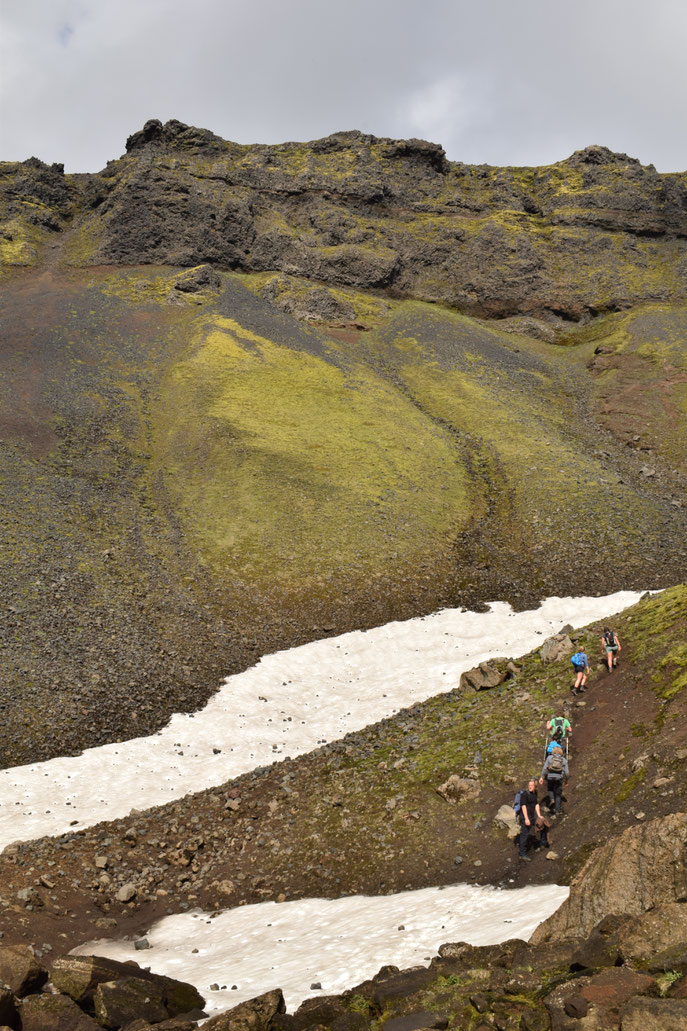



Probably what I needed at the end of those busy nine weeks was a little time alone, to recoup and reflect, clean and fix everything I owned and remember how to communicate normally again. Instead, after finishing on Friday evening with a party, we packed up our tent for 7am and caught several busses directly to Álftavatn. The last bus got stuck in a river and we had to be rescued before arriving, totally clueless to a new job.

Moving into a house after nine weeks in tents was rather luxurious and I watched the window guiltily from the corner of my eye as campers tried to battle the wind. We were grateful to be taken under the wing of Icelandic people. Speaking only the language they associate with work and bringing it into their down-time, I could understand some resistance.
Some foreigners in Iceland do little to improve our general reputation and high season has become almost insufferably busy. Left to their own devises, many would be lost forever in the highlands. It has fallen to Icelanders to try and shepherd a tourist population ten times larger than their own in order to protect both the people themselves and the environment. The weather can be brutal and the landscape is unforgiving, but though tough against the elements, these ecosystems cannot survive millions of oblivious feet. Until we learn the language and probably even then, we will always be middle men, but right now I feel lucky to be in that position.

We learnt the ropes and the barest hint of Icelandic in Álftavatn. It's called "the windy city" by the wardens and, even in perfect skies, the black pyramid Illasúla (evil pole?) loomed across the lake as a reminder of darker times. In between the more serious weather, there was a chance to go hiking. Spiky Brattháls offered views over the lakes, but the valley below Stóra Grænafjall - "big green mountain" was particularly hard to leave. I missed the lush green lindarskart when we moved further north.


We moved every couple of weeks; always hiking between huts. In Landmannalaugar, we celebrated my birthday with surprise chocolate cake, woollen socks and a clear sky from Bláhnjúkur. Our friends still in Álftavatn called to sing "Happy Birthday" in Icelandic and I drunk too much wine to stay awake very long.

As the darkness began to creep back around midnight, I started to realise my tiredness. It was as if I hadn't slept all summer.

Around Hrafntinnusker, highest hut and campsite on the Laugavegur, everything was fleeting. The fat little brown and white birds made my heart swell, but they didn't stay for long. Breaks in the clouds let in sunshine, a rainbow or even the moon; all gone before I could grasp them. We hiked as much as we could manage and didn't sleep enough. I felt I could have stayed forever, but it was finally time for a holiday.
